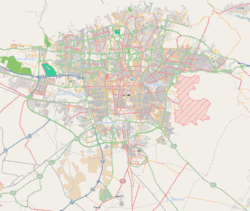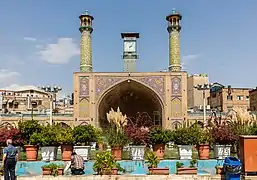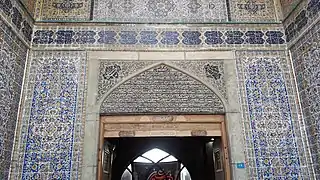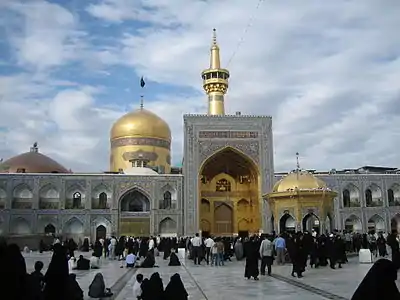Shah Mosque (Tehran)
The Shah Mosque (Persian: مسجد شاه), also known as the Soltāni Mosque[1] (مسجد سلطانی) meaning "royal", renamed the Imam Mosque (مسجد امام), after the 1979 Iranian Revolution, is a principal[2] mosque in the northern section of the Grand Bazaar in Tehran, Iran.[3]
| Shāh Mosque | |
|---|---|
مسجد شاه | |
 | |
| Religion | |
| Affiliation | Shia Islam |
| Province | Tehran Province |
| Year consecrated | 1810 to 1825 |
| Status | Active |
| Location | |
| Location | Grand Bazaar, Tehran, Iran |
 Location in Tehran | |
| Geographic coordinates | 35.6763°N 51.4221°E |
| Architecture | |
| Style | Qajar |
| Minaret(s) | 2 |
Structure
The Mosque was built to the order of Fath-Ali Shah Qajar of Persia[4] during the Qajar period, as one of several such symbols of legitimacy for the new dynasty.[5] At the time of completion, the mosque was considered to be the most significant architectural monument in Tehran.[4]
During the reign of Naser al-Din Shah Qajar, the two current minarets were added to the structure. The mosque is topped by a small gilt dome.[6] The mosque also has two Shabestan.[7]
The courtyard is accessed from several parts of the Grand Bazaar,[8] the commercial heart of the capital.[9] There are some significant architectural similarities between the Shah Mosque, the Vakil Mosque in Shiraz, and the Royal Mosque in Borujerd.
Notable events

On December 11, 1905, the vāli of Tehran ordered the public flogging of 17 prominent merchants of the Bazaar in the main courtyard of the Shah Mosque, blaming them for the increase in the price of sugar. The public humiliation of the merchants was condemned by the Bazaaris and in protest, the Grand Bazaar shut its doors. A public backlash against the government in a series of related incidents ignited the Persian Constitutional Revolution.[10]
On March 7, 1951, Haj Ali Razmara, anti-communist Prime Minister of Iran, was attending the memorial service for Ayatollah Feyz at the Shah Mosque.[11] On his way to the mosque, he was shot dead in the mosque's grand courtyard[2] by Khalil Tahmasebi, who was described as a "religious fanatic" by The New York Times.[12] According to the Encyclopædia Britannica,[13] Tahmasebi was a member of the Shiite activist group[14] "Fedaʾeyān-e Eslām (Persian: 'Self-Sacrificers of Islam'), an extremist religious organization with close ties to the traditional merchant class and the clergy."[13] In 1952, Tahmasebi was freed and pardoned by the Iranian Parliament during the premiership of Mosaddegh, and he was declared a Soldier of Islam. Following the 1953 Iranian coup d'état, Tahmasebi was re-arrested and tried; he was executed in 1955.[15][16]
Gallery
 Dome interior
Dome interior Courtyard
Courtyard
References
- Ali Razmara – prime minister of Iran, Britanica
- Iran and the Ikhwan: Assassinations, Pamphlets and Meetings Archived 2016-10-18 at the Wayback Machine, ASHARQ AL-AWSAT
- Bazaar and State in Iran: The Politics of Tehran Marketplace by Arang Keshavarzian, Page 215 (Cambridge: Cambridge University Press, 2007)
- مسجدامام خمینی / Imam Khomeini Mosque, Municipality of Tehran (in Persian language)
- The Bazaar in the Islamic City: Design, Culture, and History by Mohammad Gharipour, published by The American University in Cairo Press, page 205 – ISBN 9774165292
- The City in the Muslim World: Depictions by Western Travel Writers, Mohammad Gharipour, Nilay Ozlu
- مسجد امام خمینی / Imam Khomeini Mosque, See Iran (in Persian language)
- Imam Khomeini Mosque, Lonely Planet
- Mosque fire kills 59 in Tehran, The Guardian
- History of the Iranian Constitutional Revolution : Tarikh-e Mashrute-ye Iran by Ahmad Kasravi, Page 69-70 ISBN 9781568592534
- در دامگه حادثه / Dar Damgahe Hadese by Erfan Ghaneifard, Page 30, Persian language – ASIN B0075PW2YK
- Associated Press (8 March 1951). "Premier of Iran Is Shot to Death In a Mosque by a Religious Fanatic; PREMIER OF IRAN SLAIN IN MOSQUE Cabinet in Emergency Session VICTIM OF ASSASSIN". The New York Times. Retrieved 12 December 2016.
- "Ali Razmara – Prime Minister of Iran". Encyclopædia Britannica. 25 August 2016. Retrieved 12 December 2016.
- Denoeux, Guilain (1993). "Religious Networks and Urban Unrest". Urban Unrest in the Middle East: A Comparative Study of Informal Networks in Egypt, Iran, and Lebanon. SUNY series in the Social and Economic History of the Middle East. SUNY Press. p. 177. ISBN 9781438400846.
- Zabih, Sepehr (1982). "Aspects of Terrorism in Iran". The Annals of the American Academy of Political and Social Science. 463 (1): 84–94. doi:10.1177/0002716282463001007. JSTOR 1043613.
- "IRAN: Time of the Assassin". Time. 1 December 1952. Retrieved 12 December 2016.
External links
![]() Media related to Shah Mosque (Tehran) at Wikimedia Commons
Media related to Shah Mosque (Tehran) at Wikimedia Commons







%252C_2014.JPG.webp)




